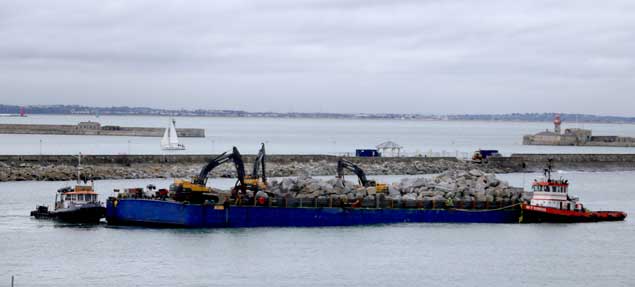Displaying items by tag: Barge Boulders
Works Begin to Bring Boulders to Scotsman's Bay Site of New Jetty at Redeveloped Dun Laoghaire Baths
#DublinBay - Works on the redeveloped Dun Laoghaire Baths project at Newtownsmith reached a significant milestone given the arrival this morning by sea of the first load of rock armour to protect a newly built jetty, writes Jehan Ashmore.
As Afloat previously reported a consignment of huge granite boulders arrived last month into Dun Laoghaire Harbour by barge since identified as the Selina. The rock armour loaded in Falmouth, Cornwall, has remained in the Irish port for almost a fortnight but is now ready to be installed to protect the new Scotsman's Bay jetty quay from erosion.
The jetty forms part of the Dun Laoghaire Baths site and is Dublin Bay's newest quay for swimming and fishing. In addition, the facility is also intended to be an embarkation point for small boats and canoes setting off into Scotsman's Bay, located between the harbour's East Pier and Sandycove. The public amenity project for Dun Laoghaire Rathdown County Council was contracted to SIAC Construction, while the design was carried out by DLR's Architects' Department, which will see a new public café linked to an outdoor terrace with views over both bays, along with studio workspaces for artists and new lifeguard facilities.
At 84m long Selina and with a beam of 20m the barge was towed by Wicklow based Alphamarine's Husky at the stern while Brixham based Marine & Towage Services MTS Indus took charge at the bow. In addition, prior to departing Dun Laoghaire Harbour, a pilot from Dublin Port Company cutter Liffey embarked to assist operations that saw the flotilla round the East Pier into Scotsman's Bay where the workboats are in close proximity of the rocky coastline.
 Tugs Husky and MTS Indus with barge Selina offload rock armour in Scotsmans bay Photo: Afloat.ie
Tugs Husky and MTS Indus with barge Selina offload rock armour in Scotsmans bay Photo: Afloat.ie
According to Dun Laoghaire Rathdown County Council, the rock armour will be stockpiled adjacent to the new jetty until it is ready to be placed into a more precise allocation. This will require off-loading of the barge by using several diggers on board, however, the operation only be carried out typically during a 3 to 4-hour window at high tide level. The operation may take between 3 to 4 high tide cycles before the work is completed to surround the jetty that is weather permitting expected to take a fortnight to complete.
DLRCoCo added during the rock armour process, there may be increased noise levels in the off-loading operations and that they apologised for any inconvenience this may cause.























































